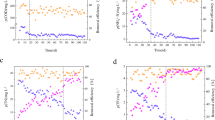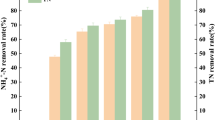Abstract
Nitrogen bioremediation in organic insufficient wastewater generally requires an extra carbon source. In this study, nitrate-contaminated wastewater was treated effectively through simultaneous autotrophic and heterotrophic denitrification based on micro-electrolysis carriers (MECs) and retinervus luffae fructus (RLF), respectively. The average nitrate and total nitrogen removal rates reached 96.3 and 94.0% in the MECs/RLF-based autotrophic and heterotrophic denitrification (MRAHD) system without ammonia and nitrite accumulation. The performance of MRAHD was better than that of MEC-based autotrophic denitrification for the wastewater treatment with low carbon nitrogen (COD/N) ratio. Real-time quantitative polymerase chain reaction (qPCR) revealed that the relative abundance of nirS-type denitrifiers attached to MECs (4.9%) and RLF (5.0%) was similar. Illumina sequencing suggested that the dominant genera were Thiobacillus (7.0%) and Denitratisoma (5.7%), which attached to MECs and RLF, respectively. Sulfuritalea was discovered as the dominant genus in the middle of the reactor. The synergistic interaction between autotrophic and heterotrophic denitrifiers played a vital role in the mixotrophic substrate environment.






Similar content being viewed by others
References
Beller HR, Zhou P, Legler TC, Chakicherla A, Kane S, Letain TE, OD PA (2013) Genome-enabled studies of anaerobic, nitrate-dependent iron oxidation in the chemolithoautotrophic bacterium Thiobacillus denitrificans. Front Microbiol 4:249
Bergaust L, Mao YJ, Bakken LR, Frostegard A (2010) Denitrification response patterns during the transition to anoxic respiration and posttranscriptional effects of suboptimal pH on nitrogen oxide reductase in Paracoccus denitrificans. Appl Environ Microbiol 76(19):6387–6396
Cao S, Du R, Li B, Ren N, Peng Y (2016) High-throughput profiling of microbial community structures in an ANAMMOX-UASB reactor treating high-strength wastewater. Appl Microbiol Biotechnol 100(14):6457–6467
Chen D, Yang K, Wang H (2016) Effects of important factors on hydrogen-based autotrophic denitrification in a bioreactor. Desalin Water Treat 57(8):1–7
Deng S, Li D, Yang X, Zhu S, Li J (2016) Process of nitrogen transformation and microbial community structure in the Fe(0)-carbon-based bio-carrier filled in biological aerated filter. Environ Sci Pollut Res Int 23(7):6621–6630
Dennis KL, Wang YW, Blatner NR, Wang SY, Saadalla A, Trudeau E, Roers A, Weaver CT, Lee JJ, Gilbert JA, Chang EB, Khazaie K (2013) Adenomatous polyps are driven by microbe-instigated focal inflammation and are controlled by IL-10-producing T cells. Cancer Res 73(19):5905–5913
Douterelo I, Boxall JB, Deines P, Sekar R, Fish KE, Biggs CA (2014) Methodological approaches for studying the microbial ecology of drinking water distribution systems. Water Res 65:134–156
Fahrbach M, Kuever J, Meinke R, Kampfer P, Hollender J (2006) Denitratisoma oestradiolicum gen. Nov., sp nov., a 17 beta-oestradiol-degrading, denitrifying betaproteobacterium. Int J Syst Evol Microbiol 56:1547–1552
Hang Q, Wang H, Chu Z, Ye B, Li C, Hou Z (2016) Application of plant carbon source for denitrification by constructed wetland and bioreactor: review of recent development. Environ Sci Pollut Res Int 23(9):8260–8274
Hua G, Salo MW, Schmit CG, Hay CH (2016) Nitrate and phosphate removal from agricultural subsurface drainage using laboratory woodchip bioreactors and recycled steel byproduct filters. Water Res 102:180–189
Kim J, Lim J, Lee C (2013) Quantitative real-time PCR approaches for microbial community studies in wastewater treatment systems: applications and considerations. Biotechnol Adv 31(8):1358–1373
Kojima H, Fukui M (2011) Sulfuritalea hydrogenivorans gen. Nov., sp nov., a facultative autotroph isolated from a freshwater lake. Int J Syst Evol Microbiol 61:1651–1655
Korom SF (1992) Natural denitrification in the saturated zone: a review. Water Resour Res 28(6):1657–1668
Lefevre E, Bossa N, Wiesner MR, Gunsch CK (2016) A review of the environmental implications of in situ remediation by nanoscale zero valent iron (nZVI): behavior, transport and impacts on microbial communities. Sci Total Environ 565:889–901
Li C, Ren HQ, Xu M, Cao JS (2015) Study on anaerobic ammonium oxidation process coupled with denitrification microbial fuel cells (MFCs) and its microbial community analysis. Bioresour Technol 175:545–552
Li W, Shan XY, Wang ZY, Lin XY, Li CX, Cai CY, Abbas G, Zhang M, Shen LD, Hu ZQ, Zhao HP, Zheng P (2016) Effect of self-alkalization on nitrite accumulation in a high-rate denitrification system: performance, microflora and enzymatic activities. Water Res 88:758–765
Li YH, Zhu JN, Liu QF, Liu Y, Liu M, Liu L, Zhang Q (2013) Comparison of the diversity of root-associated bacteria in Phragmites australis and Typha angustifolia L. in artificial wetlands. World J Microbiol Biotechnol 29(8):1499–1508
Liu CS, Zhao CC, Wang AJ, Guo YD, Lee DJ (2015) Denitrifying sulfide removal process on high-salinity wastewaters. Appl Microbiol Biotechnol 99(15):6463–6469
Ma JX, Wang ZW, He D, Li YX, Wu ZC (2015) Long-term investigation of a novel electrochemical membrane bioreactor for low-strength municipal wastewater treatment. Water Res 78:98–110
McIlroy SJ, Awata T, Nierychlo M, Albertsen M, Kindaichi T, Nielsen PH (2015) Characterization of the in situ ecophysiology of novel Phylotypes in nutrient removal activated sludge treatment plants. PLoS One 10(9):e0136424
Oon YS, Ong SA, Ho LN, Wong YS, Oon YL, Lehl HK, Thung WE (2016) Long-term operation of double chambered microbial fuel cell for bio-electro denitrification. Bioprocess Biosyst Eng 39(6):893–900
Pous N, Koch C, Colprim J, Puig S, Harnisch F (2014) Extracellular electron transfer of biocathodes: revealing the potentials for nitrate and nitrite reduction of denitrifying microbiomes dominated by Thiobacillus sp. Electrochem Commun 49:93–97
Saarenheimo J, Tiirola MA, Rissanen AJ (2015) Functional gene pyrosequencing reveals core proteobacterial denitrifiers in boreal lakes. Front Microbiol 6(674):1–12
Shen ZQ, Zhou YX, Wang JL (2013) Comparison of denitrification performance and microbial diversity using starch/polylactic acid blends and ethanol as electron donor for nitrate removal. Bioresour Technol 131:33–39
Sun S-P, Nàcher CP, Merkey B, Zhou Q, Xia S-Q, Yang D-H, Sun J-H, Smets BF (2010) Effective biological nitrogen removal treatment processes for domestic wastewaters with low C/N ratios: a review. Environ Eng Sci 27(2):111–126
Trois C, Pisano G, Oxarango L (2010) Alternative solutions for the bio-denitrification of landfill leachates using pine bark and compost. J Hazard Mater 178(1–3):1100–1105
Wang Q, Feng C, Zhao Y, Hao C (2009) Denitrification of nitrate contaminated groundwater with a fiber-based biofilm reactor. Bioresour Technol 100(7):2223–2227
Wang Z, Zhang XX, Lu X, Liu B, Li Y, Long C, Li A (2014) Abundance and diversity of bacterial nitrifiers and denitrifiers and their functional genes in tannery wastewater treatment plants revealed by high-throughput sequencing. PLoS One 9(11):e113603
Wu Y, Rui H, Yang X, Fang X, Xi C, Di Y, Zhang R (2016) Correlating microbial community with physicochemical indices and structures of a full-scale integrated constructed wetland system. Appl Microbiol Biotechnol 100(15):6917–6926
Xing W, Li D, Li J, Hu Q, Deng S (2016) Nitrate removal and microbial analysis by combined micro-electrolysis and autotrophic denitrification. Bioresour Technol 211:240–247
Yang XL, Jiang Q, Song HL, Gu TT, Xia MQ (2015) Selection and application of agricultural wastes as solid carbon sources and biofilm carriers in MBR. J Hazard Mater 283:186–192
Ye L, Zhang T, Wang T, Fang Z (2012) Microbial structures, functions, and metabolic pathways in wastewater treatment bioreactors revealed using high-throughput sequencing. Environ Sci Technol 46(24):13244–13252
Zheng M, He D, Ma T, Chen Q, Liu S, Ahmad M, Gui M, Ni J (2014) Reducing NO and N(2)O emission during aerobic denitrification by newly isolated pseudomonas stutzeri PCN-1. Bioresour Technol 162:80–88
Zhu S, Zheng M, Li C, Gui M, Qian C, Ni J (2015) Special role of corn flour as an ideal carbon source for aerobic denitrification with minimized nitrous oxide emission. Bioresour Technol 186:44–51
Acknowledgements
This work was supported by the National Natural Science Foundation of China (No. 51278034 and No. 51408028).
Author information
Authors and Affiliations
Corresponding author
Additional information
Responsible editor: Gerald Thouand
Electronic supplementary material
ESM 1
(DOCX 175 kb)
Rights and permissions
About this article
Cite this article
Li, J., Li, D., Cui, Y. et al. Micro-electrolysis/retinervus luffae-based simultaneous autotrophic and heterotrophic denitrification for low C/N wastewater treatment. Environ Sci Pollut Res 24, 16651–16658 (2017). https://doi.org/10.1007/s11356-017-9179-y
Received:
Accepted:
Published:
Issue Date:
DOI: https://doi.org/10.1007/s11356-017-9179-y




